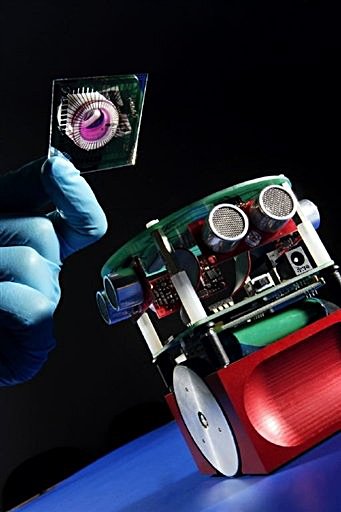A 'Frankenrobot' with a biological brain
Meet Gordon, probably the world's first robot controlled exclusively by living brain tissue.
Stitched together from cultured rat neurons, Gordon's primitive grey matter was designed at the University of Reading by scientists who unveiled the neuron-powered machine. Their groundbreaking experiments explore the vanishing boundary between natural and artificial intelligence, and could shed light on the fundamental building blocks of memory and learning, one of the lead researchers told AFP.
"The purpose is to figure out how memories are actually stored in a biological brain," said Kevin Warwick, a professor at the University of Reading and one of the robot's principle architects.
Observing how the nerve cells cohere into a network as they fire off electrical impulses, he said, may also help scientists combat neurodegenerative diseases that attack the brain such as Alzheimer's and Parkinson's.
"If we can understand some of the basics of what is going on in our little model brain, it could have enormous medical spinoffs," he said.
Looking a bit like the garbage-compacting hero of the blockbuster animation "Wall-E", Gordon has a brain composed of 50,000 to 100,000 active neurons.
Once removed from rat foetuses and disentangled from each other with an enzyme bath, the specialised nerve cells are laid out in a nutrient-rich medium across an eight-by-eight centimetre (five-by-five inch) array of 60 electrodes.
This "multi-electrode array" (MEA) serves as the interface between living tissue and machine, with the brain sending electrical impulses to drive the wheels of the robots, and receiving impulses delivered by sensors reacting to the environment.
Because the brain is living tissue, it must be housed in a special temperature-controlled unit -- it communicates with its "body" via a Bluetooth radio link.
The robot has no additional control from a human or computer.
From the very start, the neurons get busy. "Within about 24 hours, they start sending out feelers to each other and making connections," said Warwick.
"Within a week we get some spontaneous firings and brain-like activity" similar to what happens in a normal rat -- or human -- brain, he added.
But without external stimulation, the brain will wither and die within a couple of months.
"Now we are looking at how best to teach it to behave in certain ways," explained Warwick.
To some extent, Gordon learns by itself. When it hits a wall, for example, it gets an electrical stimulation from the robot's sensors. As it confronts similar situations, it learns by habit.
To help this process along, the researchers also use different chemicals to reinforce or inhibit the neural pathways that light up during particular actions.
Gordon, in fact, has multiple personalities -- several MEA "brains" that the scientists can dock into the robot.
"It's quite funny -- you get differences between the brains," said Warwick. "This one is a bit boisterous and active, while we know another is not going to do what we want it to."
Mainly for ethical reasons, it is unlikely that researchers at Reading or the handful of laboratories around the world exploring the same terrain will be using human neurons any time soon in the same kind of experiments [since shown to be an incorrect assumption – Ed].
But rats brain cells are not a bad stand-in: much of the difference between rodent and human intelligence, speculates Warwick, could be attributed to quantity not quality.
Rats brains are composed of about one million neurons, the specialised cells that relay information across the brain via chemicals called neurotransmitters.
Humans have 100 billion.
"This is a simplified version of what goes on in the human brain where we can look -- and control -- the basic features in the way that we want. In a human brain, you can't really do that," he said.
For colleague Ben Whalley, one of the fundamental questions facing scientists today is how to link the activity of individual neurons with the overwhelmingly complex behaviour of whole organisms.
"The project gives us a unique opportunity to look at something which may exhibit complex behaviours, but still remain closely tied to the activity of individual neurons," he said.

Copyright AFP 2008
Image -http://www.technovelgy.com/graphics/content08/gordon-rat-neuron-brain.jpg
For further enlightenment see –
The Her(m)etic Hermit - http://hermetic.blog.com
New Illuminati – http://nexusilluminati.blogspot.com
This material is published under Creative Commons Copyright – reproduction for non-profit use is permitted & encouraged, if you give attribution to the work & author - and please include a (preferably active) link to the original along with this notice. Feel free to make non-commercial hard (printed) or software copies or mirror sites - you never know how long something will stay glued to the web – but remember attribution! If you like what you see, please send a tiny donation or leave a comment – and thanks for reading this far…
From the New Illuminati – http://nexusilluminati.blogspot.com
No comments:
Post a Comment
Add your perspective to the conscious collective